As more and more Americans exercise their Second Amendment right to bear arms, the number of people applying for a Texas License to Carry (LTC) has skyrocketed. For many LTC holders, the ability to carry a concealed weapon provides an added layer of protection and peace of mind. One of the most popular types of firearms for concealed carry is the pistol, and for good reason. Pistols are lightweight, easy to use, and offer quick access to self-defense when needed. But with so many different types of pistols on the market, it can be difficult to know which one to choose. In this article, we'll provide a comprehensive guide to pistols for concealed carry, including an overview of how they work, the different types of pistols commonly used for concealed carry, and the advantages and disadvantages of each.
How Pistols Work
Before we dive into the different types of pistols, let's first take a closer look at how they work. A pistol is a type of handgun that is designed to be fired with one hand. Unlike a revolver, which has a rotating cylinder that holds the rounds, a pistol has a magazine that feeds the rounds into the chamber. When the trigger is pulled, the firing pin strikes the primer on the round, igniting the gunpowder and firing the bullet out of the barrel. Most pistols are semi-automatic, which means that the recoil from the fired round is used to eject the spent casing and load the next round into the chamber automatically.
Overview of Different Types of Pistols
Now that we understand the basic mechanics of how a pistol works, let's take a look at the different types of pistols commonly used for concealed carry:
Single-Action Pistols
Single-action pistols require the hammer to be manually cocked before firing. Once the hammer is cocked, pulling the trigger releases it, causing it to strike the firing pin and discharge the round. These types of pistols are generally considered to be more accurate than double-action pistols because the trigger pull is lighter and more consistent. However, they require more training and practice to use effectively.
Double-Action Pistols
Double-action pistols, as the name suggests, allow the shooter to fire the weapon in both single and double-action modes. In double-action mode, pulling the trigger both cocks the hammer and releases it, firing the round. In single-action mode, the hammer is already cocked, so pulling the trigger simply releases it. Double-action pistols are often preferred by law enforcement officers because they are easy to use and require less training than single-action pistols.
Striker-Fired Pistols
Striker-fired pistols are a newer type of pistol that have become increasingly popular in recent years. These pistols have a striker that is partially cocked by the cycling of the slide, and the trigger pull finishes cocking the striker before releasing it to fire the round. This design results in a consistent trigger pull that is easy to use and requires little training. Striker-fired pistols are also popular because they typically have fewer external controls, making them easier to operate under stress.
Advantages and Disadvantages of Each Type of Pistol
Now that we've looked at the different types of pistols commonly used for concealed carry, let's examine the advantages and disadvantages of each:
Single-Action Pistols
Advantages:
- More accurate than double-action pistols
- Consistent trigger pull
Disadvantages:
- Requires more training and practice
- Slower to fire than double-action pistols
Double-Action Pistols
Advantages:
- Easy to use
- Requires less training than single-action pistols
- Faster to fire than single-action pistols
Disadvantages:
- Inconsistent trigger pull
- Less accurate than single-action pistols
Striker-Fired Pistols
Advantages:
- Consistent trigger pull
- Easy to use
- Requires little training
- Fewer external controls
Disadvantages:
- May not be as accurate as single-action pistols
- Some shooters may not like the feel of the trigger
Conclusion
Choosing the right pistol for concealed carry is an important decision that requires careful consideration. Each type of pistol has its own advantages and disadvantages, and what works for one person may not work for another. It's important to take the time to research and try out different types of pistols before making a decision. Remember, the most important factor in choosing a pistol is finding one that you are comfortable and proficient with. With the right pistol and proper training, you can be confident in your ability to protect yourself and your loved ones in a dangerous situation.




